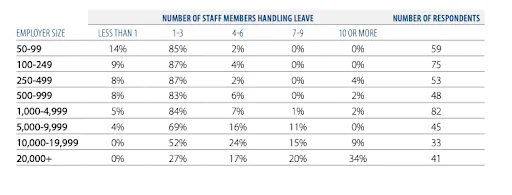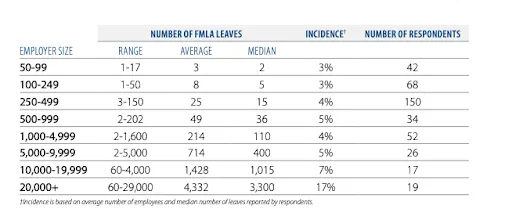Common leave management challenges: 7 examples


As companies grow, leave management challenges can impact business performance in different ways – from painstaking inconveniences to complete catastrophes.
Leave management in a small company can usually be done on-the-go with nearly all team members sitting in one room and cooperating closely. This type of management can be considered a “buddy-type,” when there is a kind of fraternity between all team members, boosting the spirit and motivation.
But with the growing size of the organization, “keeping the spirit” gets increasingly complicated. According to the Disability Management Employer Coalition survey, the number of healthcare-related (FMLA) leaves vastly increased with the number of employees. And so rises the number of employees fully dedicated to managing leaves.
With the rising numbers, the staff required to manage leaves (and the number of leaves to manage and coordinate) increases. In a company with no more than 100 employees, there are 3 health-related leaves to manage yearly, with an amount ranging from 1 to 17 depending on the company. In a company with more than 1000 employees, there is an average of 214 health–related leave days, with some employees reporting up to 600 cases.

With the organization larger than 50 employees (but smaller than 100), it is most common to employ two people to manage leaves. Only 14% of organizations of this size afford to manage leaves without employing a dedicated specialist or a leave record management system.

But every leave comes with multiple threats for the company – from the compliance issues to the lack of a key competence in a key moment. So what are these threats exactly?
Fact: According to the report, manual leave-tracking methods—like paperwork or spreadsheets—are prone to errors in leave balance calculations, undermining operational efficiency and increasing administrative workload [Source: naspe.net, 2021, Employee Leave in the Public Sector: Current Challenges and Solutions].
In this article, you will read about the hidden risks and challenges of leave management that can hurt business performance. You will learn how issues like inaccurate leave tracking, poor communication, and compliance gaps affect both employees and organizations. You will also find out how using a modern leave management system transforms leave management into a fair, efficient, and compliant process.
The Importance of an Effective Leave Management Process
Effective leave management is crucial for maintaining smooth operations and ensuring employee satisfaction. A well-designed leave management process can help organizations navigate the complexities of managing employee leave, reduce administrative burdens, and improve compliance with labor laws. By implementing an efficient leave management process, organizations can foster a positive work environment, boost employee morale, and drive business success.
A leave management process that is fair is essential for maintaining employee trust and satisfaction. When employees feel that their leave requests are being handled fairly and efficiently, they are more likely to be engaged and productive. On the other hand, a poorly managed leave process can lead to confusion, frustration, and decreased employee satisfaction.
Moreover, an effective leave management process can help organizations maintain business continuity and ensure that staffing requirements are met. By clearly understanding employee leave requests and balances, organizations can plan ahead, allocate resources effectively, and minimize disruptions to their operations.
In addition, a well-designed leave management process can help organizations comply with labor laws and regulations. By fully understanding leave policies and procedures, organizations can ensure that they are meeting their legal obligations and avoiding potential penalties.
Overall, an effective leave management process is essential for maintaining a positive work environment, driving business success, and ensuring compliance with labor laws.
Fact: According to the newest findings, AI-driven leave management systems that use predictive scheduling and real-time notifications can greatly reduce administrative burden and improve transparency in institutional leave processes [Source: ijprems.com, April 2025, A Multi-Faceted AI-Driven Leave Management Ecosystem].
Worse business performance
Companies with bad leave management (or bad HR leave software) suffer either overstaffing or understaffing – or every so often, both. A streamlined approval process can help mitigate these issues by ensuring timely responses to leave requests and reducing the risk of understaffing or overstaffing. With the unpredictability and the fluidity of available competence, the business owners feel pressure to hire more employees than it is necessary – just to be sure to keep the lights on in times of trouble.
On the other hand, though, there are skills that are relatively easy to replace, and unique ones, that cost much to find in the market and to maintain by keeping the specialist on board.
So in a time of crisis, a restaurant owner can find himself with many waiters but no chef on board.
Sticking to the example – in the understaffed company, the employee cares only about sticking to the plan, not about the customer experience or the company performance. So the waiter will be rude and impatient, and the food in the restaurant can be undercooked – both the waiter and the cook have to push themselves to their limits.
This applies to every type of business, so no matter if one runs a software house, a startup, or any other company – bad staffing is nothing to be happy about.

Overtime, burnout, and work-life balance
Overtime and burnout are just a step following the understaffing. Overworked employees tend to lose joy and a will to work. Proper leave management is crucial for maintaining a healthy work-life balance, which can prevent burnout and improve overall employee well-being. First, they just want to do their work and go out, but they need to stay longer or skip their leisure time.
The culture of overworking can be created even in a non-understaffed company, where high pressure exists. According to the Allianz Travel Insurance Vacation Confidence Index, up to 25% of Millennials are nervous and anxious about taking a leave. Up to 48% of them are not fully using their paid leave.
The source of the vacation-shaming culture is rooted deeply in the lack of leave management skills and the uncertainty about employee availability – so proper leave management and encouraging the employee to take a vacation is actually good for a company.
Increasing costs
With worse business performance and burnout come increasing costs – employees are getting sick from being overworked, and customers are dissatisfied. Implementing an efficient leave management strategy can help reduce costs associated with overstaffing, understaffing, and employee burnout. The company can either ignore the issue (and slowly slide into oblivion) or pump up the expenditures to cover the problems.
Both ways are costly and lead to a downturn.
Unhappy employees (higher turnover and lower employee satisfaction)
The employee generates costs – and it is not only about the payroll. The initial cost of hiring and onboarding can be easily overlooked, yet it delivers a heavy blow for a company. According to the Edubirdie report, the average hiring process takes up to 42 days and costs up to $4129 per hire. A well-managed leave system is essential for fostering employee satisfaction and reducing turnover rates.
Of course, finding an entry-level position employee is way cheaper and faster than hiring a senior-level one. On the other hand, though, junior employees need guidance, while a skilled senior is usually a Texas Ranger – works solitaire with immense efficiency.
No matter if we speak about the junior or senior-level employees, keeping them in the company is also a way to save money. Bad leave management that leads them to overwork and burnout is one of the easiest ways to make them leave. Or rather – run.
Legal risks
Apart from the employee-related risks that can easily drown the company, there is also a large group of legal risks associated with the leave management and lack of HR leave management software and clock in/out tool. HR professionals play a critical role in managing leave policies and ensuring compliance with legal regulations. Countries and US states vary regarding the leave system and employee rights, so staying compliant requires a good dose of knowledge. Moreover, the company needs to stay up-to-date with the changing legal environment.
Being noncompliant can end with being sued or fined. Apart from hard money costs, the situation delivers immense costs when it comes to company branding and reputation.
Challenges of Building a Leave Management System
Building a leave management system can be a complex and challenging task for organizations. One of the main challenges is ensuring that the system is fair, transparent, and easy to understand. This requires a in-depth understanding of leave policies and procedures, as well as the needs and expectations of employees.
Another challenge is ensuring that the system is compliant with labor laws and regulations. This requires a thorough understanding of relevant laws and regulations, as well as the ability to adapt to changing requirements.
Additionally, building a leave management system requires significant administrative resources. This can include developing policies and procedures, training employees, and managing leave requests and balances.
Furthermore, building a leave management system requires significant technical resources. This can include developing software, integrating with existing systems, and ensuring that the system is secure and reliable.
Finally, building a leave management system requires ongoing maintenance and support. This can include updating policies and procedures, training employees, and troubleshooting technical difficulties.
Overall, building a leave management system requires a significant investment of time, resources, and expertise. However, the benefits of a well-designed system can be significant, including improved employee satisfaction, increased productivity, and reduced administrative burdens.
Lack of flexibility
It is tempting to think that the currently-used solution will be sufficient in a more demanding environment, be that a crisis, a scaled-up business, or a sudden need to augment the workforce with a group of freelancers. Advanced management systems can provide the flexibility needed to adapt to changing workforce demands and ensure efficient leave management.
Or a pandemic, in a less optimistic scenario.
In such an environment it is common to change the workforce in an agile way, and with unsophisticated methods to manage the employees, like a spreadsheet or pen-and-paper leave management, the company can suddenly find itself in a void.
And being in a void in the middle of a crisis is a clear way to get out of the business.
Poor, unclear, and insincere communication
Finally, with bad leave management, the company cannot take care of the most vital part of the business – staff management. Clear communication during the leave request process is essential to avoid confusion and ensure that all employees are aware of their leave entitlements. And by that, there is chaos regarding the availability of leave days, who is going for a vacation, and when, or how many days there are left for each employee.
In the muddy waters of poor communication, the insincere people thrive, who seek an advantage in the unclear environment. So there are employees who abuse the leave policy and others who suffer from a lack of leave days.
And this is literally the worst way to manage people.
Summary
Leave management appears to be only a part of human resource management - it applies only when the employee wills to take a leave. But that’s not the entire truth. Leave management influences multiple elements of operations – from skill availability to internal communication – and doing that in a bad way can hurt multiple processes that would be great otherwise. Implementing robust leave management systems can streamline the process, reduce administrative burdens, and improve overall efficiency.
If you would like to master leave management and streamline your HR processes? Subscribe to our HR newsletter and get expert insights, tools, and strategies to optimize your leave management system.
1. FAQ: Common Leave Management Challenges: 7 Examples
What are the main challenges in tracking employee leave accurately?
Keeping track of various leaves manually often causes payroll errors and missing leave records. An effective leave management system that automates leave accrual and balances helps ensure accuracy and employee well-being.
How can unclear leave policies affect employees?
When leave policies and procedures are inconsistent, employees feel frustration and perceive unfairness in leave entitlements. This creates burnout and mistrust associated with leave management issues.
Why is it difficult to manage employee leave manually?
Manual leave tracking increases errors in leave data, such as miscalculating leave balance or weeks of paid leave. Using a leave management system streamlines their leave and ensures compliance with local leave laws.
What are the common challenges of leave management in growing companies?
Common challenges include inaccurate leave records, leave abuse, and lack of visibility into employees's leave status. Navigating the complexities of leave management requires management software and a proactive approach to leave management.
How does poor management of employee leave impact business operations?
If employees are on leave without a clear leave process in place, it leads to understaffing and disrupted workflows. A centralized leave management platform ensures that your leave management optimizes scheduling and employee well-being.
What approach to leave should HR teams adopt to reduce risks?
HR teams should use a proactive approach to leave management by monitoring leave usage and enforcing fair leave management policies. This transforms leave management into a fair and transparent process for all leave types.
How does an employee leave management system improve compliance?
An employee leave management system integrates leave information with payroll and HRIS to ensure compliance with the Family and Medical Leave Act and local leave laws. It also helps prevent issues with leave associated with leave entitlements and benefits.
What types of leave should a comprehensive leave system cover?
A comprehensive leave system should include paid sick leave, parental leave, bereavement leave, family leave, and extended leave. Making leave management inclusive of various types of leave available ensures fairness in leave benefits.
Why is mastering leave management crucial for employee satisfaction?
Effective leave management isn’t just about administration; it’s about fostering employee well-being and reducing burnout. When employees feel confident to request leave under clear policies, they are more likely to stay engaged and productive.
How does leave management software help optimize your leave management process?
Leave management software automates leave processes, manages leave accrual, and provides visibility into entire leave usage across departments. This makes leave management accurate, fair, and easy to navigate despite the complexities of leave management.
Read more our texts about general HR
- The business consequences of being late to work
- Top 5 Games for Team-Building
- Public holidays worldwide: 5 interesting facts
- How to Increase Employee Engagement at Your Company
- How the HR Software Can Change Your Workplace
- How a joke can be the solution for lateness?
- 3 key trends in HR management you should be ready for
- “Follow Your Dreams“ — the Millennial's mantra
- Why Should HR Professionals Not Be Scared of Artificial Intelligence?
- 19 top team building games for remote employees
- How to convince your boss to choose time off and attendance management software?
- 7 ways how bad HR leave management system hurts your business
- Menstrual leave – everyday life or still something surprisingly rare?


















